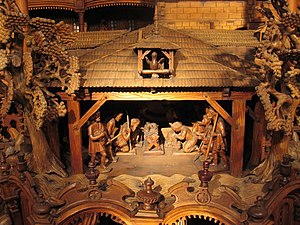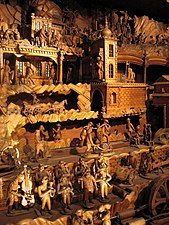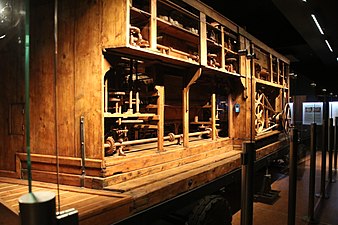Probošt nativity scene
The Probošt crib ( Czech Proboštův betlém ), also Třebechovice crib or crib of Třebechovice ( Czech Třebechovický betlém called), is a Christmas crib of wood with mechanically moving figures. In addition to scenes from the Christmas story , the nativity scene depicts other scenes from the life of Jesus , especially from his Passion , and also scenes from everyday life in Třebechovice. It originated in the Bohemian town of Třebechovice pod Orebemover a period of more than forty years and is exhibited in the local Nativity Museum. Since 1999 it has been one of the national cultural monuments of the Czech Republic .
story
The crib was built by Josef Probošt (1849–1926), Josef Kapucián (1841–1908) and Josef Friml (1861–1946). The farmer and carpenter Probošt wanted “to create a nativity scene that will be the largest and most beautiful in the world, so that the emperor will surely come from Vienna to see it himself.” The nativity scene was created in the period from 1882 until Joseph's death Probošts 1926 in several stages. Originally, Probošt created a simple traditional nativity scene, which he gave to his wife in 1885. Gradually he added more biblical scenes. He was helped by the carver Josef Kapucián, who carved most of the figures, while Probošt himself mainly worked on landscape and architecture. Finally, Probošt added scenes from the everyday life of the residents of Třebechovice to the nativity scene.
In the 1890s, Probošt got to know movable nativity scenes and decided to rebuild his nativity scene accordingly. A photo from this time shows that the crib was originally built in a right-angled corner construction. The focus was the corner with the birth scene. At the turn of the century, the nativity scene was rebuilt into a linear form, presumably in connection with its mechanization. The mill builder Josef Friml, who built mechanisms for mills and agricultural implements, constructed a functioning movement mechanism. This allowed 150 figures to be moved on belts and almost fifty figures could be moved with heads or limbs. The mechanism was originally driven by a hand crank, and from 1935 by an electric motor.
The nativity scene was publicly exhibited for the first time in 1906 at the Zemská jednota řemeslnická (National Craftsmen Association) in Chrast . After Probošt's death, his daughter sold the crib in 1934 to Jaroslav Burdych (1892–1957), a factory owner from Třebechovice. Exhibitions followed in 1934 in Kostelec nad Orlicí , 1935 in Prague , 1936 in Brno and 1937 in Bratislava , Piešťany and Hlohovec . After the Second World War, the Burdych family was expropriated and the crib became state property. A request was made to destroy it as a “product of religious obscurantism ”, but fortunately this was not approved.
The nativity scene became internationally known through the world exhibition in Montreal in 1967 , at which it was viewed by over 8 million visitors. In 1968 it was exhibited in the Dutch miniature city of Madurodam in The Hague and in 1970 at the Ideal Home Show in London . Since 1972, the crib has been housed in the Třebechovice Crib Museum (Třebechovické muzeum betlémů). In 1974 a major restoration took place. Since then, a thorough inspection and the necessary maintenance work have been carried out at the end of each calendar year. During the new construction of the museum from 2011 to 2013, the crib was moved to a depot and could not be viewed. In 2013 it was transferred to the newly built museum and has since been open to the public again. From 2015 to 2016, it was completely restored right in the museum's exhibition room in front of the museum's visitors.
In 1958 the crib was declared a cultural monument and in 1999 a national cultural monument.
description
The crib is 6.90 meters wide. It is 2.20 meters high and 1.90 meters deep. Both the scenes shown and the mechanics used to move the figures are made of wood. The wooden frame of the superstructure has been reinforced by a steel structure since 1972. The individual scenes are spread over seven levels, some of which merge into one another as terraces and some are separated from one another by false ceilings.
Of the roughly 2000 carved parts of the nativity scene, 363 represent figures, the rest are architectural or landscape elements. This also includes six delicately carved flowering linden trees , which at that time were a common part of Czech nativity scenes. The left side shows the landscape around Třebechovice. There are folk buildings such as a windmill, a water mill, a hermitage, and a sheepfold. The landscape is crowned by a chapel with a bell tower whose bell is rung. The right side shows a palace architecture with strong walls, columns and towers. The approximately 10 to 15 centimeters tall figures are carved from linden wood and not polychromed . Probošts served as models for many of the figures. Probošt himself is also shown as a carpenter and Kapucián as a wise old man. About 50 figures can move their heads or limbs with the help of wire pulls, for example to carry out work processes, and about 120 figures are moved through the scenery by wooden chains. Most of these movements are horizontal. However, a group of figures is moving up a ramp. The mechanism for driving the figures is made of hornbeam and beech wood and includes over three hundred wooden wheels and 152 toothed wheels with a diameter of 10 to 60 centimeters.
The biblical scenes are predominantly arranged on the upper levels. They depict events from the life of Jesus from his birth to his ascension . The focus is on the Christmas story and the Passion . In the center of the Probošt nativity scene is the stable of Bethlehem on the third level, flanked by two linden trees. Joseph cradles the baby Jesus in the manger, the shepherds kneel in front of it and take turns bowing their heads. The Annunciation of the Lord and Mary's visit to Elisabeth are depicted under the stable . The Annunciation to the Shepherds is shown on the left side of the crib from the fifth level upwards. On the right, on the fourth level, the procession of the Magi with camels and an elephant is moving towards the stable. Other scenes from the childhood story of Jesus include the presentation of Jesus in the temple , the flight into Egypt and the murder of children in Bethlehem . The passion scenes are mainly shown on the fifth to seventh level. Many scenes show Jesus with the cross on the way of the cross . Further scenes show the Lord's Supper , the Mount of Olives scene and the crucifixion of Jesus . The scene of the Descent from the Cross is carved from a single piece of wood by Joseph Kapucián. The series of biblical scenes ends with the ascension of Jesus on the upper level.
Mainly secular scenes are arranged on the lower levels. They depict events from the everyday life of the inhabitants of a small Bohemian town like Třebechovice at the turn of the 19th and 20th centuries. On both sides of the central building of the crib, on the lowest level, there are the moving figures of a boy and a girl holding pewter bowls in their hands and thereby to remind visitors to leave donations. Two steam engines to the right and left of it indicate the technical progress of Třebechovices. On the left side there is a shoemaker's workshop , next to it an open hallway in which a baker is stirring the bread dough and a farmer's wife is pounding butter. In addition, a cooper , a wheelwright and two blacksmiths work outdoors. On the right side is a turner shown on a lathe. On the right edge, a tunnel with miners is shown under the palace architecture . The second level does not go the full length of the crib. A carpenter is working on the left , and a band is playing next to it . A man is transporting wood with a wheelbarrow, and two carpenters are working next to him. On the right, a weaver is working on a hand loom, next to it two men are chopping down a tree with a saw. On the third level, secular and biblical motifs merge. Local artisans and biblical figures move from either side to the stable in the middle and bring their gifts. On the left, a butcher is sharpening his knife on a grinding wheel. On the right side the holy family is shown, Joseph at work, Jesus carrying wood and Mary in prayer.
See also
Web links
- Probošt nativity scene. In: Website of the Třebechovice Nativity Museum. .
- The Probošt nativity scene. In: Třebechovice Tourist Information Center website. .
- Třebechovický betlém. In: List of monuments of the National Institute of Cultural Heritage (Národní památkový ústav). (Czech).
- The most famous nativity scene in the world or the ingenious work of master Probošt. In: Youtube. Třebechovické muzeum betlémů, December 21, 2017(video with detailedrecordingsand sequences of movements).
Individual evidence
- ↑ a b c d e f g h i j Třebechovický betlém. In: List of monuments of the National Institute of Cultural Heritage (Národní památkový ústav). Retrieved December 6, 2021 (Czech).
- ^ A b Zita Zemanová: Třebechovický Proboštův betlém . Ed .: Třebechovické muzeum betlémů. Hradec Králové 2004, p. 156 (Czech).
- ↑ Joseph Probošt, quoted by Jiřina Hánová, František Valena: betlémy: české a moravské lidové betlémy a jejich tvůrci . Lika klub, Praha 2002, p. 14-15 (Czech).
- ↑ a b c Probošt Christmas crib. In: Website of the Třebechovice Nativity Museum. Retrieved December 6, 2021 .
- ↑ Vladimír Vaclík: Lidové betlémy v Čechách a na Moravě . Vyšehrad, Prague 1987, p. 27 (Czech).
- ↑ Václav Šplíchal: Poselství dřeva . Golempress, Letohrad 2007, p. 545 (Czech).
- ↑ a b The Probošt nativity scene. In: Třebechovice Tourist Information Center website. Retrieved December 6, 2021 .
- ↑ Vladimír Vaclík: Lidové betlémy v Čechách a na Moravě . Vyšehrad, Prague 1987, p. 22 (Czech).
- ↑ Jiřina Hánová, František Valena: Betlémy: české a moravské lidové betlémy a jejich tvůrci . Lika klub, Praha 2002, p. 16-17 (Czech).
- ↑ Václav Šplíchal: Poselství dřeva . Golempress, Letohrad 2007, p. 544 (Czech).
- ↑ Vladimír Vaclík: Lidové betlémy v Čechách a na Moravě . Vyšehrad, Prague 1987, p. 1187 (Czech).






